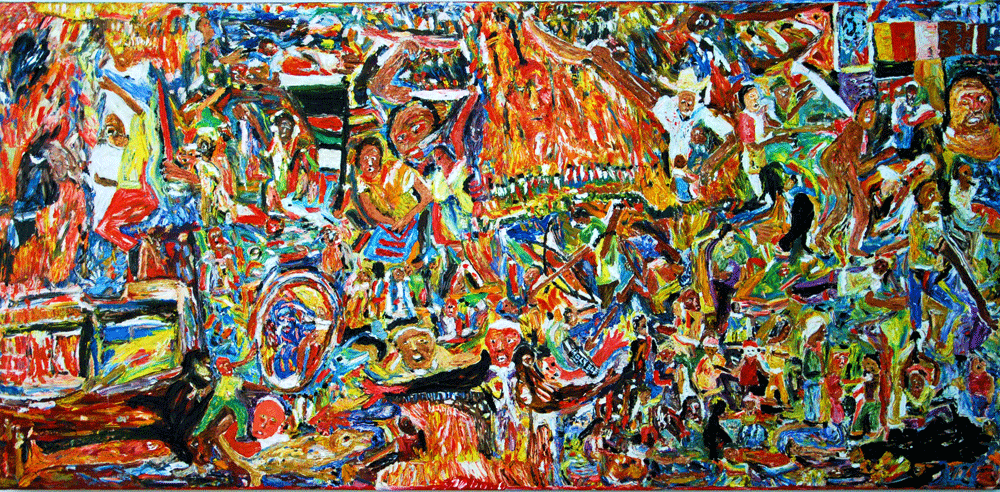Wanyu Brush, Jak Katarikawe and Sane Wadu
Watatu Gallery
Watatu Gallery

Following Kenya’s 2007 post-election violence – in which 1,500 civilians were killed and nearly 250,000 displaced – the socio-political and artistic psyche of the country experienced a dramatic crisis of identity, precipitated, in large part, by the associated media images of extreme brutality that circulated in real time around the world. Characterized, often erroneously, by Western media outlets as a largely tribal clash between rival ethnic groups, the bloody conflict – which included instances of mass immolation, beheadings and rape – bore the mark of so-called ethnic cleansing and evoked the quagmire of the Mau Mau rebellion of some 50 years earlier. Inspired, or rather revolted, by this iconography of violence and its deeper impact on the Kenyan conception of heritage, East Africa’s three most celebrated painters – Wanyu Brush, Jak Katarikawe and Sane Wadu – assembled at Watatu Gallery with the difficult task of responding to this national crisis.
The problems such a show might present reside not only in the sensitive nature of the topic but also in the very real possibility that the exhibition might lapse into political parody. The mythologies surrounding Brush, Katarikawe and Wadu have veered dangerously close to African ‘outsider’ portraiture – including narratives of savagery and insanity – and have thus made all three artists attractive to certain Western galleries and subjected their work to hagiographic interpretations. Brush’s Boschian scenes of urban apocalypse mimic this kind of Art Brut aesthetic, which perfectly encapsulates the violent iconography of the election riots. The large abstractions, with their splashes of vibrant, primary colours and dense configurations of human and animal forms mingling in flat relief, also command the most immediate attention. His Never, Never, Never Again (2011) is the consummation of this particular abstract expressionist style; it’s a danse macabre that depicts the brutality of the Kenyan riots in the style of Picasso’s Guernica (1937). The detailed grotesqueries in Brush’s paintings, while closest in spirit to the purview of the exhibition, do, however, belie a pronounced lack of depth of field and their grandiosities often overwhelm any complex sense of perspective – an accusation often levied at Francis Bacon, whose work is a kindred influence on that of Brush.
The relationships between art and violence in Wadu and Katarikawe’s works are a different story altogether. The former’s subtle colour palette and restrained biomorphic representations are almost lost when placed alongside those of Brush, but pieces such as Shall We Crucify Him (2009) and Don’t Worry Be Happy (2009) reveal a delicate sense of light and balance reminiscent of the post-impressionists. Rather than producing an overwhelming sensorium of colour as an index of violence, Wadu works in shadows, highlighting individual faces and bodies, some austere and soulful, others hideous and tortured. This attention to faces seems medieval and folkloric at times, accompanied as it is by stars, crescents, guitars and crosses. The resulting tableaux, ostensibly dedicated to contemporary atrocities, appear less fixated on the encounter of violence than in the psychic and spiritual aftermath.
Katarikawe, an Apollonian antithesis to Brush and a more rural companion to Wadu, rejects the folly of the urban world altogether, instead celebrating village and wildlife in soft, Edenic forms. His anthropomorphized images of goats, zebra and elephants depict the animals as huddled in conversation or whispering secrets into the ears of attending humans. Using pastels and earthen hues of brown and grey, the Ugandan-born painter mines anecdotal and proverbial sources, exaggerating his subjects into dream-like characters à la Marc Chagall and Henri Rousseau. According to a popular story, when Katarikawe first learned of these European forebears, he insisted that they copied his work and then, upon learning of their age, concluded that they had all shared the same dreams. The only hint of death in Katarikawe’s paintings exists by implication – We Are Happy Til the Butcher Comes (2010) and Don’t Worry, He Will Come Back (2009) – as though the animals are awaiting the inevitable slaughter of their human masters. Although responding in radically different ways to dramatic events in Kenyan history, all three painters have created a refreshingly magical series that, whilst deeply personal, never retreats into political didacticism.






















